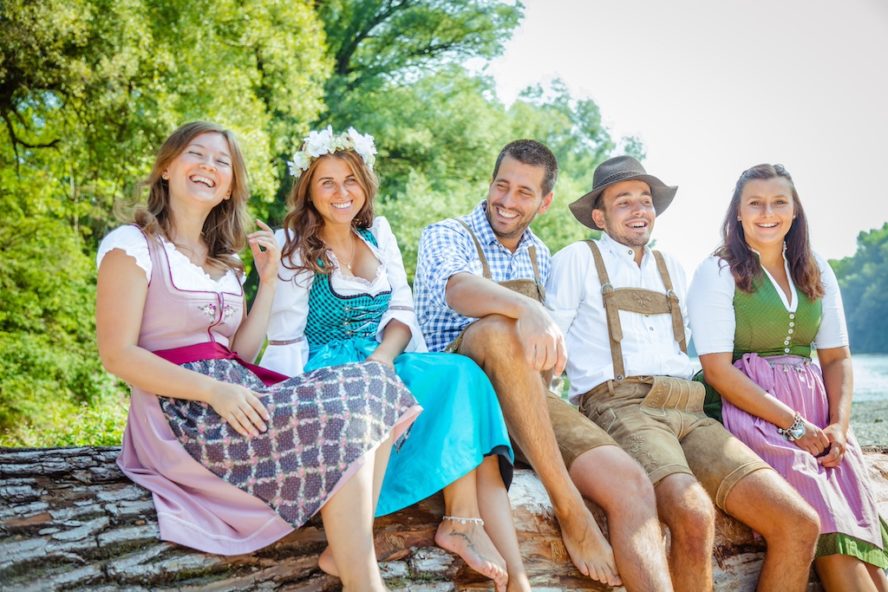Lederhosen are famous leather pants from Germany and Bavarian countries, and they have a fascinating history. It was originally worn by laborers in the 18th century because it was designed for better durability, especially in outdoor work. Over time, Lederhosen evolved symbolized as a cultural heritage. Today, Lederhosen men are closely associated with Oktoberfest and continue to be a cherished part of Germanic culture worldwide.
Origin of Lederhosen
Lederhosen was not a traditional costume when they were invented; it was actually created as workwear for peasants. Germans commonly wear leather items. It’s durable, making it a favorite for demanding jobs among workers, including farmers.
French Influence:
By the 18th century, Austrian and German workers had adopted the culottes style, choosing reliable leather over soft French fabrics. The Lederhosen, also known as “leather breeches“, emerged as leather culottes.
Distinctive Features:
What sets Bavarian Lederhosen apart from other European leather pants is their length. While some Lederhosen extended past the knee, the everyday version in the Austrian and Bavarian Alps was cut above the knee.
Workers and hunters appreciated this shorter length for better mobility, especially on the steep slopes of the Eastern Alps. The exact origin of this cut remains uncertain, but the first written account dates back to 1835 during August Lewald’s tour of Tuxertal, Tyrol.
Preservation and Cultural Identity:
As everyday use of Lederhosen declined beyond the Eastern Alps, efforts arose to preserve this alpine tradition. In 1883, school teacher Joseph Vogl established the Association for the Preservation of the National Costume in the Leitzach Valley and Bayrischzell (Upper Bavaria).
This model inspired other preservation clubs known as Trachtenvereine, which spread across the outer edges of the Eastern Alps, from Munich to Salzburg and Vienna.
Bavarian rulers, including King Ludwig II, supported these efforts, reinforcing a national Bavarian identity. Lederhosen became symbolic attire for outdoor activities like horse riding and hunting.
Overcoming Obstacles – A Legacy of Resilience
Despite gaining traction, Lederhosen also faced opposition. Notably, the Bishop of Freising condemned them as the “work of Satan” in 1913. This, however, only served to strengthen the resolve of lederhosen enthusiasts. The traditional attire symbolized regional identity and defiance against societal pressures.
Parts of Lederhosen
Lederhosen is more than just a single piece of clothing. But it’s a collection of attire that resonates with the outstanding cultural experience of Bavaria. Multiple parts to traditional German lederhosen give an amazing appearance when you wear them; these parts are;
Leather Trousers:
These are the core of Lederhose, carefully created from durable leather. These trousers come in various color combinations like green, black, and brown. Additionally, the length of trousers are above knee length; but some trousers even include simple embroidery.
Leather Suspenders:
These leather suspenders are an important part of wearing Lederhosen. They come in multiple unique styles, such as “H” or “V” shapes. Like leather trousers, these suspenders have various embroidery options, giving them an attractive look.
Checkered Shirt:
To make your Lederhosen simple yet attractive, choose checkered or solid-colored shirts, and the colors of the shirt can be green, red, or blue. Wearing these colors and styles gives your ensemble a touch of authenticity.
Socks:
Socks are also an integral part of Lederhosen; without them, the Lederhosen outfit is not completed. The colors of the socks can be different, but Bavarians choose specific colors of socks, such as hunter-green, gray, and cream, with Lederhosen.
Shoes:
Shoes are the main thing that completes the look of the Oktoberfest Lederhose style. Haferl shoes in black or brown effortlessly tie together with Lederhosen, making them indispensable.
What is Damen Lederhosen
Damen lederhosen, customized for women, has gained popularity since the 1880s, becoming synonymous with social events and festivities. These sleek designs often feature decorative elements like colorful beads and floral patterns, giving them a feminine touch.
Damen lederhosen are commonly paired with traditional German or Austrian-style tops and can be worn with flats or, in some cases, high heels. They also complement casual footwear like sandals.
Global Appeal of Lederhosen
While historically associated with laborers, Lederhosen has undergone a transformation in recent years, becoming symbols of celebration and nostalgia. Popular during Oktoberfest, they serve as timeless costumes, cherished for their connection to simpler times. Lederhosen have transcended borders and are liked by individuals worldwide, particularly in the United States and Europe, as essential components of cultural costumes and festive attire.
Final Thoughts
Throughout the above history of Lederhosen, you learn one important thing: Lederhosen has smartly evolved from workwear to a celebration of cultural pride in Germany. There is no doubt that Lederhosen has transcended boundaries because of its origins as practical attire and its great emergence as a fashionable statement.
Now, it has gained global recognition. Today, both women and men like Lederhosen because of its cultural symbol and diverse styles. So, whether you are dressing up for Oktoberfest or want to appreciate its great cultural heritage, German Lederhosen will always remain a unique symbol of tradition, celebration, and resilience.
Frequently Asked Questions
What was the historical journey of Lederhosen?
Lederhosen began as practical workwear for peasants, then transitioned to upper-class fashion for activities like hunting. After time, Lederhosen became a pride symbol of Bavarian identity.
Do you dress up for Oktoberfest?
While dressing up isn’t obligatory, wearing lederhosen and dirndl adds to the Oktoberfest atmosphere. Whether you are Bavarian by blood or enjoy the festivities, seeing people wearing their Lederhosen and Dirndl adds charm to the festival.
- The Future of Fashion Accessories: Durable and Sustainable Choices - August 29, 2024
- 8 Creative Ways to Personalize Your Engagement Ring - August 26, 2024
- Eco-Friendly Wedding Fashion: Sustainable Choices for the Conscious Bride - August 26, 2024
- How Stylish Sunglassеs Can Rеdеfinе Your Evеryday Look? - August 26, 2024
- Essential Beauty and Fashion Tips to Create Stunning Looks with Confidence - August 25, 2024

